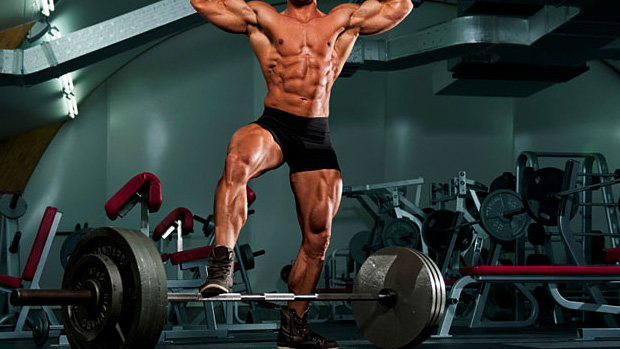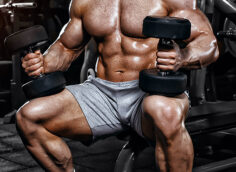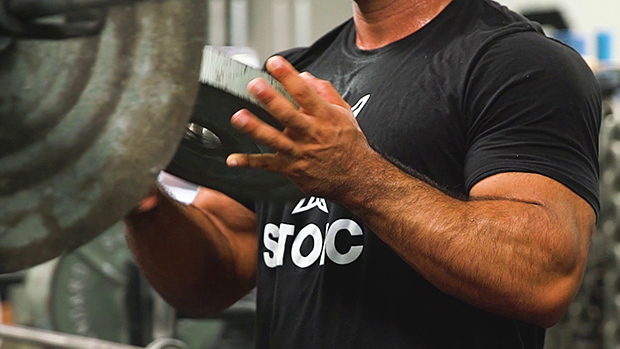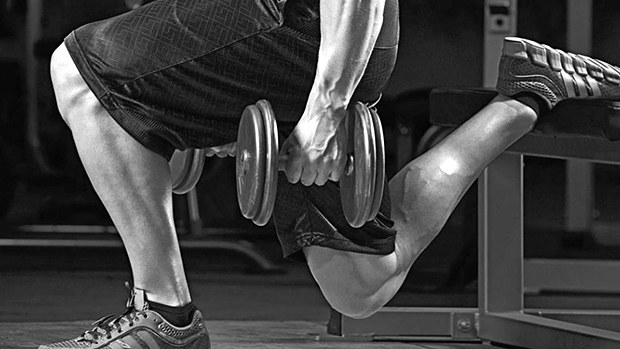Young guys do stupid things. It's how we're wired. When we aren't doing stupid things, we worry about stupid things, focusing on trivia at the expense of shit that really matters.
So it's no surprise that most of us carry that propensity for fucking up and fucking off into the gym when we work out.
Some of our mistakes are basic, some are more technical, and some are even debatable. But the common theme is clear: we can all use some help.
That's why I contacted three veteran coaches – Robert Dos Remedios, Tony Gentilcore, and Chris Bathke – and asked them to identify and correct the 10 most common mistakes they see young lifters make.
Ignoring their advice? Well, that would just be stupid.
Do you want to look like Stan McQuay? Own the mat like Georges St. Pierre? Get your name on the board at Westside Barbell?
Or are your goals more modest? As Bathke says, "Some guys just want to look like Matthew McConaughey, hang out in Malibu, and punch photographers."
There's no wrong answer. Your goals are your goals. The hell with anyone who tries to tell you otherwise.
But what you can't do is leave your success to chance by following a training program that wasn't designed for you. Whatever goals you have, you can't reach them with workouts created with an entirely different outcome in mind.
"If you want to be a professional bodybuilder, and have the same genetics and pharmacist as Mr. Universe, then I see no problem with training like him," Dos Remedios says. "But, if you just want to look good and hook up with the ladies, then you have to understand that his bodybuilding methods may not be your best option."
Why not?
"When you're following a program that's not in line with your goals, you're just wasting a ton of time doing things that frankly are not that fucking important," Gentilcore says.
Bodybuilding, just to pick one example, is an activity that requires you to build each muscle group to its maximum size, with the best possible body composition and, Zeus willing, an appealing and symmetrical overall shape. If that isn't your goal, it makes no sense to invest the time and effort required to do bodybuilders' workouts. At the same time, if your goal is to be a successful, contest-ready bodybuilder, then you won't get there doing jump squats and speed work or anything else specific to a running back or sprinter.
The bottom line: Figure out what you want to look like and how you want your body to perform, then find a training program specific to those goals. Which brings us to ...
You can't go to the gym and "wing it" if you haven't yet built a base of size and strength in those wings. "If you want to be cock-diesel, then you can't screw around," Dos Remedios says. "Your body needs constant stimulus and overload. That means having a big-picture, periodized plan of attack for at least 10 to 12 weeks. Minimum."
A periodized training program might start with a four-week phase designed to increase muscle size and develop a base of conditioning. You'll do higher-volume workouts with weights that may be lighter than you're used to using. That's followed by a combined strength-and-hypertrophy phase, using heavier weights for four weeks. The next stage would move you toward more serious strength development.
Ideally, the periodized program should be set up something like this:
"Most guys, especially if they're just beginning, should be on a three-day-per-week, full body program with a ton of compound movements, and focusing on perfect form," Gentilcore says. "Each day you have a main lift" – deadlift variation, squat variation, bench press – "and add some accessory work around that."
In those 12 weeks, a previously unfocused lifter would probably make bigger gains than he's made with years of self-designed programs. And a genuine novice would get started the right way.
The bottom line: Everyone needs to build a strong base before moving on to more advanced or specialized routines. And, although we used a 12-week example here, in reality you can spend years doing periodized training for size and strength and continue seeing progress. But before any of that can happen, you have to stick with a single program longer than three days.
Mobility+ joint integrity + addressing muscle imbalances = good training strategy.
Excessive flexibility + lifting pussy weights + addressing problems you don't actually have = near-total waste of your time and energy.
"I remember this one guy who walked into our facility and was talking about how weak his gluteus medius was," Gentilcore says. "But I took one look at the guy and immediately thought, 'Are you fucking kidding me? You're 150 pounds and your whole body is weak!' Who gives a shit about your glutes when you can't even deadlift your own body weight?"
Being mobile and flexible is great, but not at the expense of working hard.

The bottom line: Knowledge is good, as they used to say at Faber College. Mobility, stability, and muscle balance are all essential. But at some point you have to take the training wheels off the bar and lift some actual weights.
For every guy who worries too much about his lateral stability in the sagittal plane of movement, you'll find dozens, if not hundreds, who have the opposite approach:
"Most of the guys I've seen who are following the bodybuilder body-part splits are all out of whack," Bathke says. "They're rarely doing any pulling exercises and look more like a hunchback than anything. They're the type of posturing, preening idiots my female clients laugh at."
There's an obvious fix here: balance the volume and intensity of your pushing and pulling movements in the major movement patterns. So you do the same amount of work on rows and other horizontal pulls as you do on bench presses and other horizontal pushes. For every set of overhead presses, you do a set of chin-ups or pulldowns with an equally challenging load.
But that's only one part of the problem. The other part is the emphasis on your smallest muscle groups.
"I understand you want big arms, but what the hell is the purpose of training your biceps for 45 minutes straight?" Gentilcore asks. "It's no bigger than a baseball. Besides, if you can't do five pull-ups with good form, you shouldn't even be doing a curl of any kind. Your arms will grow once the rest of your body grows."
According to Dos Remedios, getting jacked is a by-product of sound performance-style training. "I've got a newsflash for all the skinny dudes who flex their nuts on the leg press: I've seen chicks do reps with 700 pounds. How bad-ass do you feel about your 10 plates now?"
His advice: Avoid leg presses, Smith machine squats, and anything else that doesn't use your muscles in a way that resembles athletic movement, or that has no obvious transfer to sports performance. Choose squats, deadlifts, cleans, lunges, and step-ups over exercises that involve sitting in a machine with your back, ankles, and/or feet braced against pads.
The bottom line: Stand up to do your lower-body exercises. Make sure your upper-body workouts achieve a balance of pushing and pulling exercises. And choose compound movements involving multiple joints (hips and knees; shoulders and elbows) over those that attempt to isolate single muscle groups. Stick to the basics and let your body move the way it was designed to.
Your body won't get bigger, stronger, or leaner unless you force it to. That means working harder.
Look at it this way: Your body looks and performs the way it does now because it's adapted to your current level of effort. Sure, you can scratch out some minor gains by changing the exercises or altering some other variables unrelated to effort. But the biggest changes will come from overloading your muscles, rather than merely giving them something different to do.
"Ninety-nine percent of guys in the gym have no concept of what actual hard work is," Dos Remedios says. "You can have the greatest program laid out for you, but if you aren't leaving everything you have on the gym floor, you aren't going to see results."
The bottom line: Does that mean you have to puke after every training session? Hell no. But you do need to make sure your workouts include progressions that allow you to lift more (using heavier weights and/or doing more sets and reps) or lift harder (shortening the rest period between sets and/or choosing more challenging exercise variations).
"I'm not sure why, but guys still think they need to do an hour of cardio after they train with weights," Bathke says. What's wrong with that? "Most of the guys doing it are the ones who weigh a buck forty and have no reason whatsoever for burning that many calories or wasting that much time."
Even if you are a little on the chunky side and want to lean down, steady-state endurance exercise is probably a poor choice for you. First, the fact you're chunky suggests you don't have a body type that adapts well to endurance exercise. Second, the fact it's boring (that's why gyms put their cardio machines in front of TV sets) means you're unlikely to stick with it long enough to get the results you want, even if your body responds to it. I mean, what's the reward for getting into better shape? You need to exercise longer just to break even.

Bathke says you're much better off performing intervals and other, more unconventional types of cardio. "Go outside and run up a hill, or do some intervals on your bike. Throw on a weighted vest and run some sprints."
If going outside isn't an option, "pick up some kettlebells and do some complexes and circuits mixed with body-weight stuff," Bathke suggests. "You'll get more done in 10 minutes than you ever would on a treadmill in 60."
The bottom line: Whether you're inside or out, mix things up, break a sweat, challenge your coordination. You might actually have some fun. Stranger things have happened.
As Mike Robertson and Eric Cressey outlined in their "Neanderthal No More" series, most guys just have no idea how bad their posture really is. The most insidious and common problem is tight hip flexors and tight pecs due to long-duration sitting, which leads to the rather un-sexy caveman look.
"You've got guys who are on the computer eight hours a day," Gentilcore says. "They're sitting in the car, they're sitting at a desk, they're sitting at lunch, they're sitting at meetings... then they head to the gym and sit down to do lat pull-downs, pec flies, crunches, military presses, and leg presses. Get the hell up and move around a bit. Your hip flexors will thank you."
You'd be surprised how many common gym exercises you can do without sitting. Leg exercises (as noted earlier), shoulder presses, and curls and extensions are no-brainers; there's no advantage to doing those sitting down.

You can also do one-arm chest presses standing up, using a cable-crossover machine with the pulley set somewhere in the middle of the apparatus, instead of the top or bottom, where you usually find it.
It's even easier to do non-sitting pulls. Barbell and dumbbell bent-over rows are obvious (and good) choices. You can do standing face pulls on the cable-crossover machine using the high-pulley setting, and standing one- or two-arm rows with the pulley in the middle.
Another great choice is the horizontal chin-up, using a barbell set up in the squat rack at about hip-height. You're only limited by your imagination on this exercise. You can change your grip (underhand for more biceps work), change the position of your feet to make it easier or harder, or even try it with one arm instead of two if you're feeling ambitious.
And that's assuming you're already doing pull-ups and chin-ups whenever possible instead of lat pulldowns. But even on lat pulldowns, there's no rule that says you have to sit with your knees locked under the pad. You can sit without the pad over your knees, which brings more stabilizing muscles into play, or even do them kneeling, if you can make the setup work in your gym.
The bottom line: Give yourself a no-sitting rule in your workouts. Do everything on one or two feet, even your ab exercises. (Once you've tried standing cable crunches, you may never go back on the floor.) Be creative with your pushes and pulls, mixing up one- and two-arm exercises. Add some mobility exercises for your hip flexors before your workouts and do some stretches after. You'll find your posture, along with your physique, gets better in a hurry.
If you think girls go for big biceps and chest, I suggest you head to the bar and check out the reactions girls have to a guy wearing a skin-tight shirt and walking around with a bad case of ILS (imaginary lat syndrome).

Or just ask Bathke what he hears from his female clients: "I've had plenty of girls tell me how horrible guys look with no legs and ass – especially if they have a big or defined upper body."
Combine an unbalanced physique with a peacock strut, and you're guaranteed to turn off the very girls you're trying to impress.
The solution is pretty simple: You already know you need to balance pushing and pulling exercises for your upper body (point #4). You also need to balance lower-body and upper-body work. The sets and reps may not be equal, but in terms of sweat equity, the overall effort you put into squats and deadlifts should equal or even exceed the effort you put into upper-body pushes and pulls.
The bottom line: Develop your power areas – glutes, hamstrings, shoulder girdle – and you'll have a full-spectrum physique, one that looks strong and athletic from any angle.
As TC once wrote, "Something magical happens when you put three or more plates on one side of the bar."
That "magical" thing is more muscle growth.
Intermediate lifters – those who've been training consistently for a year or more, and have made measurable gains in strength and size – often find themselves at a plateau. They haven't hit their genetic limits; they've just gone as far as they can with traditional workout configurations – three sets of 10, four sets of eight.
"You need to start experimenting with heavier loads, especially over 90 percent of your one-rep max," Gentilcore says. "No matter your goal, getting stronger is the simplest way to make progress. As long as you keep good form, you'll add more muscle and push past some plateaus." (For more details, check out the Rule of 90 article.)
How soon should you start going heavy? Sooner than most of us think.

"If they've got great form, I actually take a lot of clients down to five reps within eight weeks of training," Bathke says. That's probably not a great idea for novice lifters working out on their own, but for intermediates, it can be the difference between staying on the plateau and climbing toward the next peak.
The bottom line: The old weightlifting adage "go heavy or go home" may just be the greatest piece of advice for an experienced lifter struggling to add more muscle.
A little experience in the weight room can bring out an unflattering quality in some young guys. They become weight-training snobs, laughing at newbies and taking offense at anyone who offers a few words of advice.
"I saw this kid at the gym, probably 18 years old, doing some of the exercises wrong," Dos Remedios recalls. "I went over to help him and he basically told me to screw off. I didn't have the heart to tell him that I wrote the fucking book he had in his hand."
Similarly, if you genuinely know what you're doing, and you're someone who's regarded with respect in your local gym, it's okay to share. "Sure, there are times you have to be careful with what you say and how you approach it," Gentilcore says. "But if you throw someone a bone every now and then, it could do wonders for their self-esteem and growth."
The bottom line: If you need advice, take advice. Or, even better, ask for it, especially if you're trying out some new exercises and aren't confident you're doing them right. And if you're the kind of guy others ask for advice, be generous. Of course you can't walk around the weight room correcting everyone's form. But if you see someone with that distinct look of the insecure newbie, the kind of guy who doesn't even know what questions he should ask, be a hero and help him out. It might make his day, with no risk to yours.
While it's certainly not a complete list, applying these 10 tips will put you in a league of your own, or at least a level above the frat boys who curl in the squat rack and scare away the cute girls.
Now it's your turn. The discussion thread is open, and operators are standing by.





